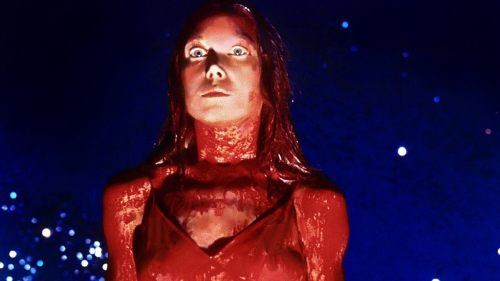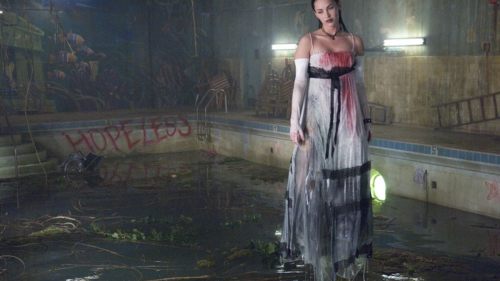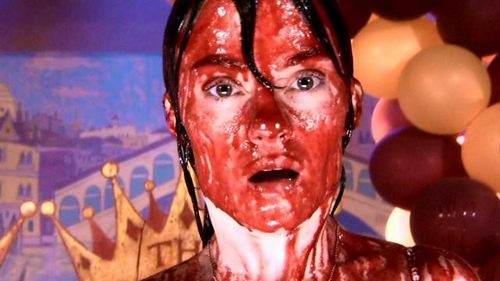From CARRIE To THE LURE: Monstrous Girls In Cinema
Raw is coming out soon. Get your tickets here!
Within the Madonna-whore dichotomy, itself already an unwinnable game, there's a strange space in between that's reserved for monstrous girls. They share some characteristics with the final girl in that some bloody trauma is usually the key to self-discovery, but the final girl's story ends on that note of growth and escape. For the monster, it's only the beginning. With growth comes the ability to seize agency and to experience pleasure, i.e. the chance to be free. They're given the chance to embrace it and revel in it, but it's a freedom that's always punished in the end. The monster has to die for there to be a happy ending.
It's a pattern that's strangest when one considers that the transformation from girl to monster always seems to be a way of referring to female growth, specifically with regards to the transition from girlhood into womanhood. There's an easy in, after all — girls going through puberty is already an inherently bloody process, and menstruation is still something that's relatively taboo when it comes to open discussion, e.g. pads and tampons are still a source of shame and cheap comedy rather than recognized as tools and necessities. As a result, menstruation is still largely a mystery to those who have yet to or will never go through it. Neither Carrie nor Ginger Snaps bother with much subtlety on that front; Carrie (starring Sissy Spacek) opens with Carrie's first period and her ensuing panic as she doesn't understand what's happening to her, and Ginger Snaps starts with a girl's first period as well, as Ginger Fitzgerald (Katharine Isabelle) is bitten by a werewolf that's drawn by the scent of the blood.
Both are cases of girls being preyed upon for being stereotypically innocent or virginal, but flouting the mould doesn't guarantee safety, either. Jennifer's Body plays with the rule, as Jennifer (Megan Fox) is butchered in a ritual sacrifice because of a miscommunication — her murderers think she's a virgin. But it's a small mercy. One of the more parodied rules in horror is that you can't have sex unless you want to die; in that sense, Jennifer's fate was sealed either way. It doesn't matter whether a girl is classically "good" or "bad;" either way, everyone else has an idea of what she ought to do with her body. And when the straw finally starts to break the camel's back, the girl's body rebels.
All three examples offer a certain empowerment and freedom, which is all well and good in theory but becomes something to be stamped out when it's freedom from the societal bounds that are usually imposed upon women. They're suddenly free (and able) to embrace their own appearances, and they're free to act with confidence. They talk back, they do what they want to do, they know their worth. They learn to love what they're told makes them ugly, in this case literally. And that just can't stand. The beauty they manifest in being independent must be branded as taboo because it's not in service of anyone else but themselves. Granted, there's a little problem in that they're driven to kill or outright eat people, but that's part and parcel with the larger metaphor. The price these girls have to pay for agency is always bloody, and not just with regards to menstrual blood. Carrie is quite literally drenched in it before she finally snaps, Ginger is mauled, and Jennifer is stabbed to death before coming back as a riff on a succubus. And even then, they continue to have to pay a cost. They pay for playing inside the rules, and they pay for breaking them, too.
Even the rare endings in which monstrous girls don't die have to be somehow qualified. The Witch's Thomasin (Anya Taylor-Joy) is freed from the Puritan shackles of her family life, but it's at the cost of her family itself, and her "freedom" is in the hands of the very witches who'd taken her family from her. She laughs as she joins their circle and rises into the air, but it's not pure joy that suffuses her voice. What choice does she have, after all, other than to join them? Her family was cast out of its settlement, and there's nothing else out there in the woods. The Lure, meanwhile, features two man-eating mermaids and spares just one of them, though tearing them apart in such a way is arguably worse than killing them both.
The monstrous girl has always had to play within a set of rules — an ultimate irony, considering that their ultimate crime is trying to break free. She cannot find love so long as she hangs on to what makes her different. She is weak if she does not embrace the supernatural; she is evil if she does. She is ugly as a monster with agency; she is underestimated as a girl without it. She can’t be a girl, but she can’t be a woman, either. She must always suffer in order to gain power, and she must always ultimately give it up. It’s an unfair game given that all she’s really doing is growing up. But there’s evidence that she may soon be able to break out of her cage. Jennifer’s Body ends with her best friend (Amanda Seyfried) killing her, yes, but she becomes a monster, herself, and uses her powers to take out the men who’d killed Jennifer in the first place. The Lure doesn’t punish its man-eaters for their nature; in a break from tradition, it’s the monstrous one who survives, and the sweet one is allowed to choose the nature of her demise. And if there are some monsters left standing despite having been put through the ringer, isn’t there some hope that those who come next might break the chain?



